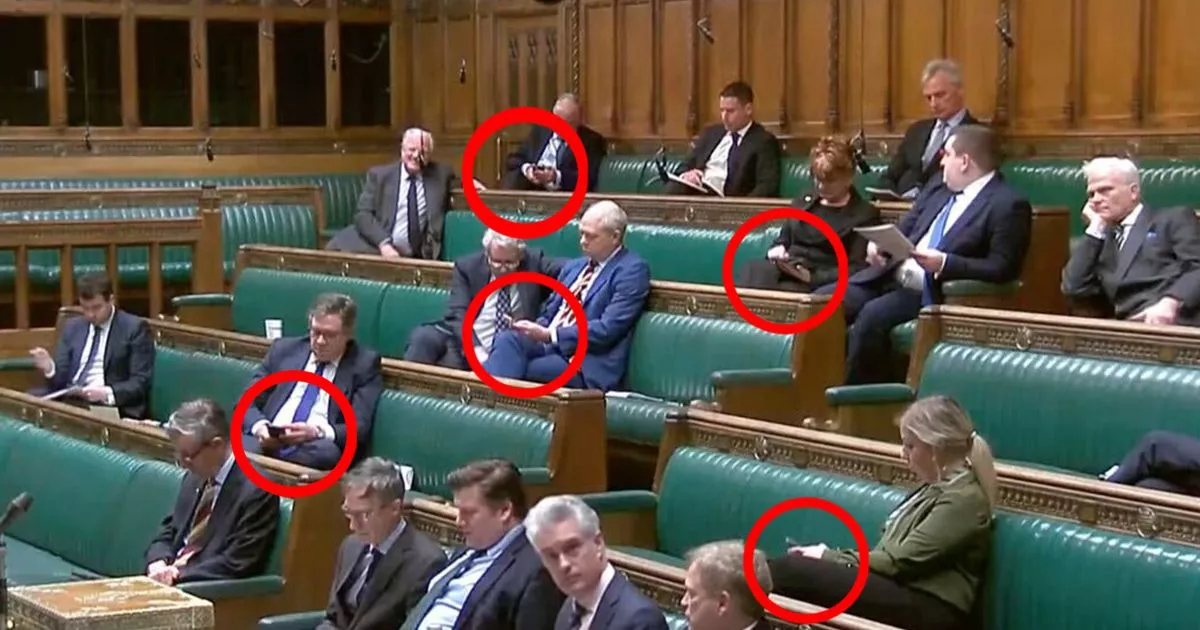Inconsistency Exposed: Tory MPs Hooked on Phones Despite Ministerial Push for Student Phone-Free Zones
Conservative MPs were seen using their mobile phones in the House of Commons just hours after the government announced a crackdown on mobile phone use in schools due to concerns about distraction. Education Secretary Gillian Keegan has called for a ban on mobile phone use during the entire school day, including break and lunch times.
Despite this, Tory MPs were observed using their phones in the Commons chamber. The new guidance for schools includes options such as a complete ban on mobile phones, requiring students to hand in their phones before class, or enforcing a policy where phones are kept in bags and confiscated if taken out.
The government has cited data showing that 29% of secondary school students reported unauthorized mobile phone use, but some education leaders doubt that the new guidance will have a significant impact.
In the bustling chambers of the House of Commons, Conservative Members of Parliament found themselves engrossed in the glow of their mobile phones, a stark contrast to the very message echoed by government ministers mere hours earlier. The paradox unfolded on a day marked by Education Secretary Gillian Keegan’s firm directive to schoolchildren: disconnect from your devices during the school day.
As headlines blared with announcements of a crackdown on mobile phone use in classrooms, the scene in Parliament hinted at a disconnect between policy rhetoric and real-world behavior. While ministers emphasized the detrimental effects of digital distractions on students’ learning, Tory MPs, caught in the parliamentary whirlwind, seemed ensnared by the allure of their screens.
Within the Commons chamber, amidst discussions ranging from defense strategies to economic crises, Conservative backbenchers were spotted glued to their mobile devices—a tableau of irony amidst the very discourse of device regulation. Treasury Minister Bim Afolami faced a barrage of questions about the country’s economic trajectory while Business Minister Nus Ghani casually perused her phone nearby, a subtle reminder of the ubiquity of digital distractions in modern life.
Meanwhile, in the educational realm, Gillian Keegan’s message to educators reverberated with a call to action: banish mobile phones from the school day entirely. The guidance issued to headteachers echoed concerns over the loss of focus and academic productivity attributed to unchecked device usage. From lesson times to breaks, the directive left no room for ambiguity—mobile phones were to be relegated to the periphery of school life.
In practical terms, schools were presented with a menu of options to enforce the ban, ranging from confiscation protocols to stringent locker policies. The aim? A learning environment untethered from the pervasive influence of handheld screens. Yet, amidst the fervor of regulatory fervor, questions lingered about the efficacy of such measures. Would a mere policy shift suffice to curb the ingrained habits of a digital generation?
Government data cited a staggering 29% of secondary school pupils reporting unauthorized mobile phone use—a statistic underscoring the scale of the challenge at hand. Despite the government’s concerted efforts, skepticism abounded within the educational sphere. The Association of School and College Leaders cast doubt on the feasibility of the new guidelines, highlighting the nuanced nature of device dependency beyond the school gates.
General Secretary Geoff Barton pointed to the nuanced reality of digital compulsions, noting that while classrooms may offer a structured environment, the crux of the issue lies in the unregulated landscape outside school walls. The allure of screens, he suggests, extends far beyond the confines of educational institutions, permeating the fabric of daily life.
Amidst this complex tapestry of regulations and realities, the juxtaposition of parliamentary scenes and educational imperatives paints a vivid picture of society’s fraught relationship with technology. As policymakers grapple with the challenge of digital governance, the dichotomy between rhetoric and reality serves as a poignant reminder of the multifaceted nature of contemporary discourse.
In the corridors of power and the hallways of learning, the mobile phone dilemma persists as a microcosm of broader societal tensions—a tug-of-war between connectivity and concentration, regulation and autonomy. As educators and legislators alike navigate this ever-evolving landscape, the quest for balance remains an enduring pursuit—a delicate dance between empowerment and restraint in the digital age.

